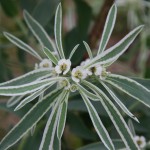Snow-on-the-Mountain, Snow on the Mountain
Euphorbia marginata Pursh
Euphorbiaceae (Spurge family)
Description
Snow on the Mountain is an annual herb in the spurge family. It typically grows between 1 to 3 feet or 0.3 to 0.9 m tall. Stems are erect, with many branches. It has small and showy leaves that range from light green to variegated or are entirely white. The flowers are small, with whitish, petal-like bracts, and form clusters atop the stems. Bloom time occurs from July to October. This plant has no forage value for mammalian wildlife. Mourning doves eat the seeds, and it serves as a nectar source for bees and butterflies. Honey produced from the nectar and pollen of this plant can irritate or burn the throats of its consumers.Habitat
Snow-on-the-Mountain is locally abundant in Central Texas. It is somewhat uncommon in the Rio Grande Plains and Trans-Pecos regions. It also grows north to Montana and Minnesota and south to Mexico. It is found most often in tight clayey soils of swales and meadows and in dry stream beds. Populations can vary greatly from year to year. Native habitat includes dry slopes, disturbed prairies, and roadsides.Toxic Agent
The white sap of these plants has long been used to blister the skin or as an intestinal purgative. In most cases, livestock are poisoned by an acrid principle that severely irritates the mouth and gastrointestinal tract. This plant rarely causes death. Experimental feedings of this plant in Texas have shown that 100 ounces produce severe scours and weight loss in cattle, the latter persisting for several months.Signs of Livestock Ingestion
Primary signs include: Severe irritation of mouth and gastrointestinal tract; Diarrhea.Management Strategies
Most species of spurge can be grazed to a limited degree without problems. Their bitter white juice apparently makes most species unpalatable. Administer intestinal astringents if needed to relieve diarrhea and intestinal wall irritation. Although most broadleaf herbicides control the plant easily, it is generally uneconomical to control as a primary target species. Proper mineral supplementation, especially of phosphorus, reduces livestock losses to the plant.Images
Plant Characteristics
Flower Color: Green, White
Seed Type: Bean/Pod
Duration: Annual
Stem Texture: Hairless/Smooth
Growth Habit: Forbs/Broadleaf
Leaf Shape
 : Simple with Pinnate or Parallel Venation
: Simple with Pinnate or Parallel Venation
Season: Warm
Distribution
 : 01 - Pineywoods, 02 - Gulf Prairies and Marshes, 03 - Post Oak Savannah, 04 - Blackland Prairies, 05 - Cross Timbers and Prairies, 06 - South Texas Plains, 07 - Edwards Plateau, 08 - Rolling Plains, 09 - High Plains, 10 - Trans-Pecos
: 01 - Pineywoods, 02 - Gulf Prairies and Marshes, 03 - Post Oak Savannah, 04 - Blackland Prairies, 05 - Cross Timbers and Prairies, 06 - South Texas Plains, 07 - Edwards Plateau, 08 - Rolling Plains, 09 - High Plains, 10 - Trans-Pecos
Distributions
Distribution refers to the ecological region in Texas that a plant has been found. You can also view a clickable map.
Book: Toxic Plants of Texas (B-6105)
Collection: Toxics, Wild Flowers
Livestock Affected: Cattle
Livestock Signs: Abdominal Pain, Colic, Diarrhea, Loss Of Weight







